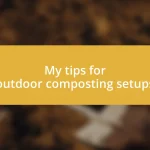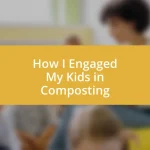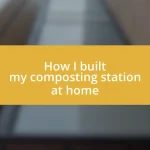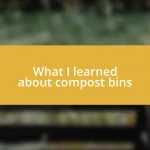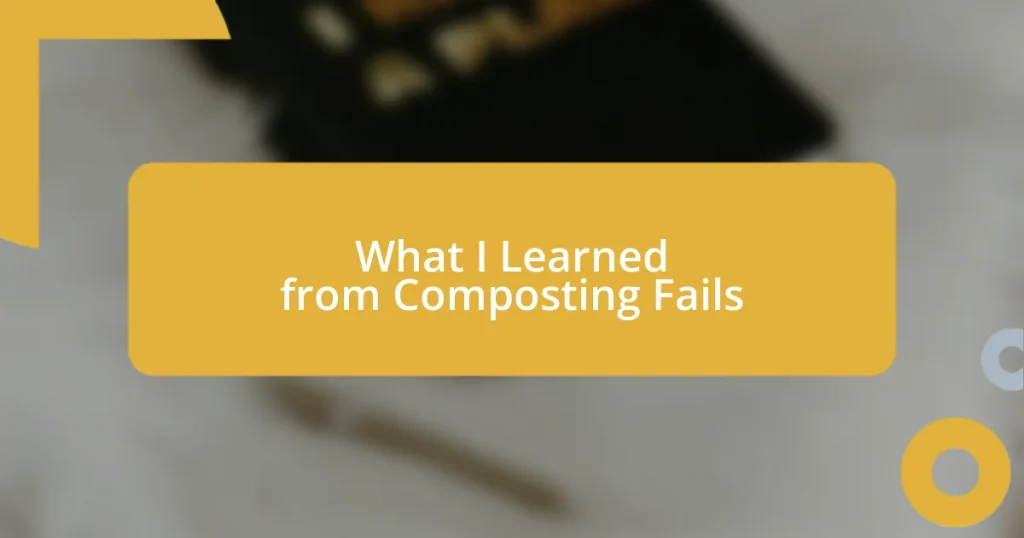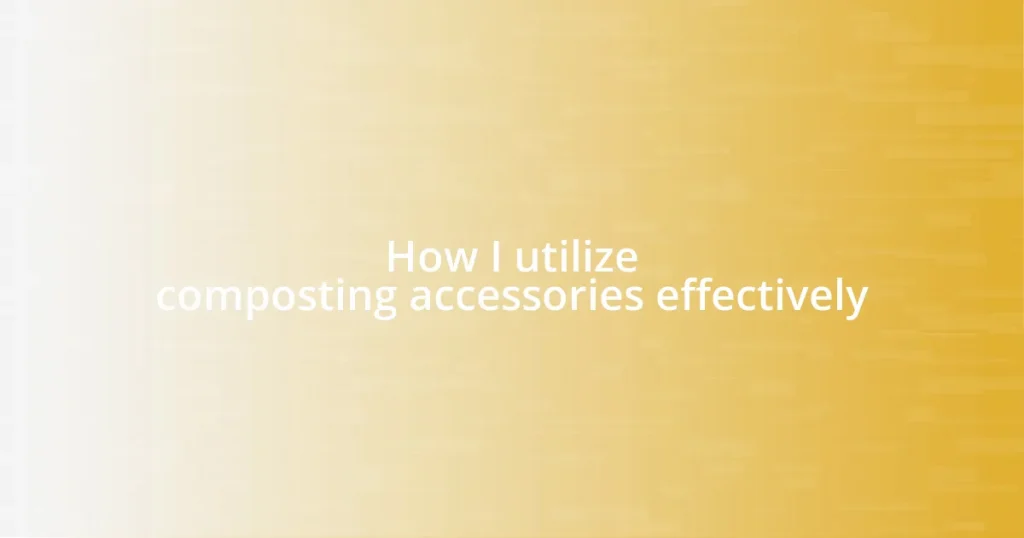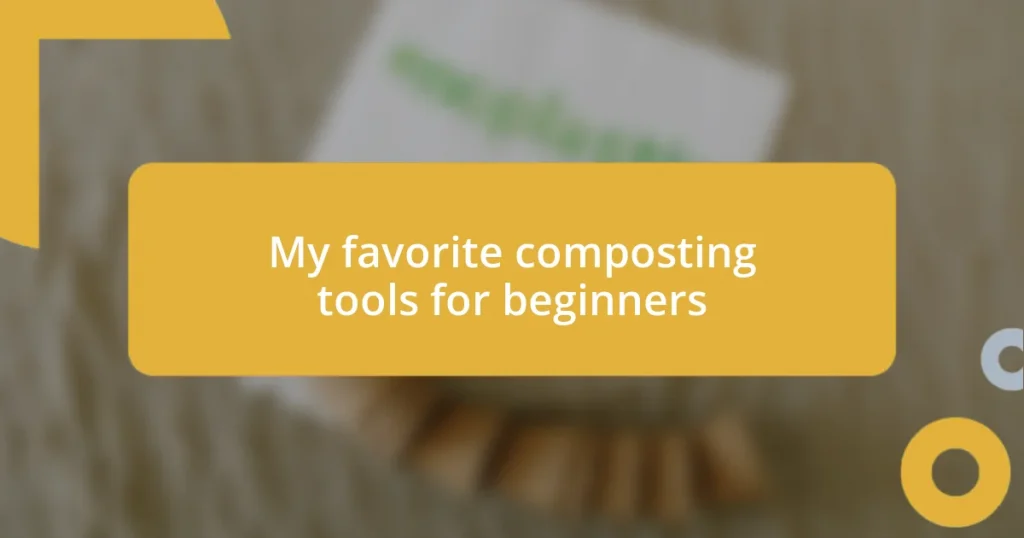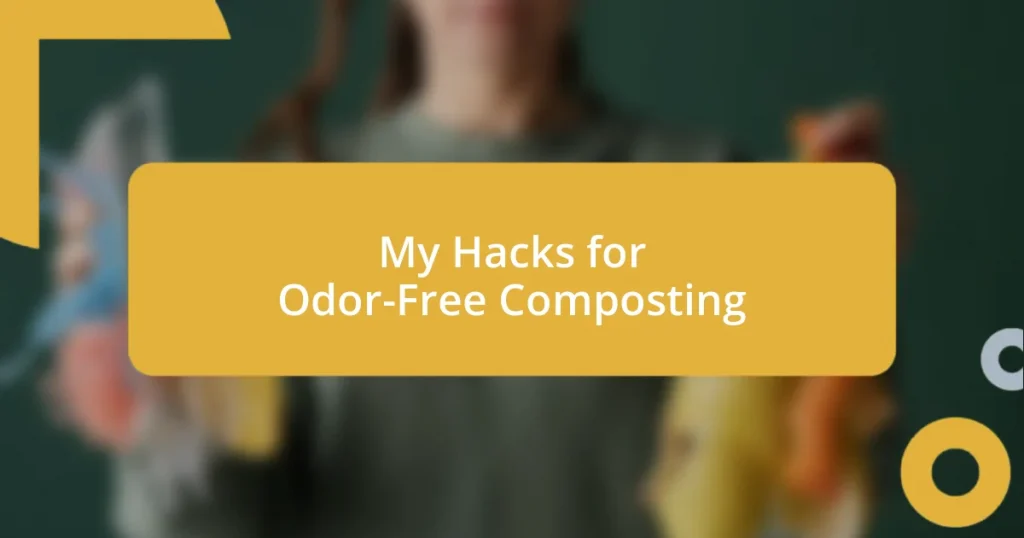Key takeaways:
- Understanding the importance of material balance is crucial; excess citrus or inappropriate food scraps can lead to unpleasant results.
- Regular aeration, moisture control, and monitoring temperature significantly enhance composting success and reduce odors.
- Learning from failures is essential; each mistake provides valuable lessons that contribute to improved composting techniques and outcomes.

Introduction to Composting Fails
When I first ventured into composting, my enthusiasm was high, but I quickly learned that not everything goes as planned. The fresh aroma of grass clippings mixed with kitchen scraps was enticing, yet the reality of composting can sometimes feel like a messy experiment gone wrong. Has anyone else found themselves staring at a bin full of unrecognizable mush, wondering where it all went south?
One memorable failure for me involved adding too many citrus peels, thinking I could boost the flavor of my compost. Instead, I ended up with a stinky, acidic mess that drove both my compost and my enthusiasm into hiding. It made me realize how crucial it is to understand the balance of materials in composting. Have you ever tossed in something you thought would be a great addition, only to face the aftermath of a composting disaster?
Navigating composting can often feel like a trial-and-error journey. Each mishap brings valuable lessons, making me appreciate the process more deeply. These experiences, while sometimes disheartening, ultimately shape our understanding and growth as composters. It’s a comforting thought, isn’t it, that every failure brings us one step closer to success?

Common Composting Mistakes
It’s easy to fall into the trap of thinking any organic matter is compostable. I remember tossing in leftover pizza with cheese and all, feeling like I was doing something productive. Instead, I ended up with an uninviting, moldy concoction that attracted fruit flies. It taught me that not all food scraps belong in the compost bin; items like dairy, meats, and oils can create more problems than they solve.
Another common mistake I’ve encountered is the tendency to neglect aeration. I once ignored my compost pile for weeks, letting it compact down. When I finally turned it, you wouldn’t believe the smell—like something died in there! This experience helped me realize that oxygen is essential for the decomposition process. Regularly turning and mixing the compost not only helps with odors but also speeds up breakdown.
Lastly, there’s the issue of moisture levels. In my early experiments, I was so focused on adding greens that I overlooked the browns. My bin turned into a soggy mess that oozed instead of decomposing. Now, I know the importance of a balanced carbon-to-nitrogen ratio. By remembering to layer materials properly, I’ve achieved much better results.
| Common Mistake | Personal Experience |
|---|---|
| Adding inappropriate materials | Tossing in pizza led to mold and fruit flies. |
| Neglecting aeration | Ignoring turning my compost created unbearable odors. |
| Improper moisture levels | Focusing too much on greens made my compost soggy. |

Lessons Learned from Failed Attempts
Having navigated through the erratic waters of composting, I’ve gleaned some insights that can really turn those failures into stepping stones. One of my more cringe-worthy moments involved forgetting my compost for weeks under the sweltering sun. I opened the bin expecting to find nutrient-rich gold, but was met with a foul odor that made my eyes water. This experience starkly reminded me that composting is not a “set it and forget it” process; it demands attention and care.
When reflecting on my composting failings, I learned to appreciate the delicate balance of materials I add. For instance, I once thought that excess greens would be beneficial, only to discover the resulting gooey pudding was a far cry from the earthy elixir I envisioned. It’s crucial to remember that every addition impacts the overall success of the compost. I’ve created a little checklist that I now refer to:
- Know Your Materials: Ensure only compost-friendly items go into the bin.
- Aerate Regularly: Turn the pile often to maintain airflow and reduce odors.
- Maintain Moisture Balance: Keep an eye on the texture of your compost—balance greens and browns for best results.
- Stay Engaged: Regularly check on your compost’s progress to catch potential issues early.
These lessons, albeit learned the hard way, have enriched my composting journey in ways I never anticipated.

Troubleshooting Composting Problems
One issue that I frequently encountered was the dreaded mushroom invasion in my compost bin. At first, I was thrilled, thinking, “Wow, my compost is thriving!” But soon enough, I realized these weren’t the edible kind. It dawned on me that excessive moisture and insufficient aeration can create a perfect breeding ground for unwanted fungi. Now, I remind myself that not every growth is a good sign. Monitoring moisture levels and ensuring I mix things up has become a habit.
Another time, I noticed the odorous aroma wafting from my compost was more akin to a landfill than to the earthy scent I desired. After some investigative work, I discovered the cause: an imbalance of nitrogen-rich greens and carbon-dense browns. Reflecting on this, I’ve realized that composting is a bit like cooking; a pinch too much of one ingredient can completely ruin the dish. I invested in a simple scale to help me keep track of my ingredients and it’s made a world of difference.
The most frustrating moment for me was when my ambitious pile seemed to just sit there, refusing to break down. It was disheartening, like watching paint dry. I learned that sometimes, all it takes is a little patience and a good toss to wake it up! I now treat composting like nurturing a garden; it requires attention, periodic checks, and a dash of kindness to flourish. Isn’t it amazing how much we can learn from our composting missteps?

Effective Strategies for Successful Composting
When it comes to effective strategies for successful composting, I’ve found that the key lies in starting with a solid foundation. Imagine my surprise when I discovered that simply layering my materials properly could transform my composting efforts! I learned to start with coarse materials, like twigs or cardboard, at the bottom of my bin. This creates airflow, preventing that suffocating sludge which I so dreaded. Isn’t it fascinating how something as simple as layering can have such a profound effect?
Another vital strategy I’ve embraced is the importance of monitoring temperature. I remember the first time I felt the warmth radiating from my compost pile; it was like finding a hidden treasure! This warmth isn’t just a cozy feeling; it indicates successful microbial activity. Keeping a thermometer handy took my composting game to the next level. When the temperature drops, I know it’s time to aerate or add more green materials. Who knew that checking a temperature could be so enlightening?
I also discovered that timing is of the essence. My composting journey hit a significant turning point when I realized the benefits of patience—yes, patience! There were times I excitedly dug in only to find that my materials hadn’t fully broken down, but now, I understand that some materials take longer than others. It’s a process, and I’ve learned to embrace the wait. Reflecting on this, I often ask myself, “Why rush something so wonderfully transformative?” Composting truly rewards those who are willing to enjoy the journey!

Maintaining Balance in Compost
Maintaining balance in compost is like finding the sweet spot in a relationship; too much of one thing or the other can lead to disaster! My first experience with this balance involved a huge pile of grass clippings I was so proud of. I didn’t realize until later that my nitrogen levels shot through the roof, leaving me with a smelly mess. I learned that a careful combination of greens and browns—a true yin and yang—creates a harmonious compost.
One practical approach I adopted is the “one-third rule.” I aim for one part greens, one part browns, and one part water. It sounds simple, but trust me, it can be a game changer! I still remember how I felt when I started seeing steam rising from my pile, a magical moment that told me I finally struck that perfect balance. There’s something incredibly rewarding about witnessing the transformation that comes from mixing the right elements. Do you think balance is difficult to achieve in your own composting adventures?
I also became friends with diverse materials. I once threw in some shredded newspaper alongside kitchen scraps, and let me tell you—it felt like I had opened a treasure chest of possibilities! It’s a reminder that not all elements are created equal. Some materials might surprise you with how they contribute to the mix. I like to think of composting as a sort of alchemy—mixing these ingredients in just the right way can yield something truly valuable. Isn’t it exhilarating to consider the endless combinations at our fingertips?

Conclusion and Future Improvements
Reflecting on my composting journey, I’ve realized that failures are often the best teachers. Each hiccup, whether it was a too-wet pile or an imbalance of greens and browns, provided me with invaluable insights into my gardening practices. It’s amazing how embracing these lessons fueled my determination to create a thriving ecosystem in my compost bin.
Looking ahead, I see immense potential for improving my techniques. For instance, I’m ready to explore better composting tools, like specific aerators or bins with improved airflow designs. I can’t help but wonder, how will these upgrades enhance my compost quality? The prospect of watching my compost transform even faster excites me; it feels like I’m gearing up for yet another exciting chapter in this rewarding adventure.
Ultimately, composting pushes us all to evolve. Each failure serves as a stepping stone toward mastery. As I continue adjusting my methods and experimenting with new materials, I’m reminded to remain open-minded and patient. Isn’t it fascinating how this process mirrors life itself, where growth often springs from our missteps?



